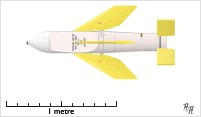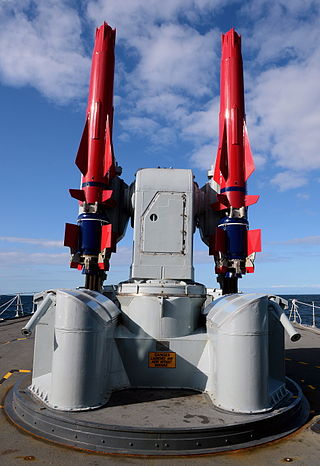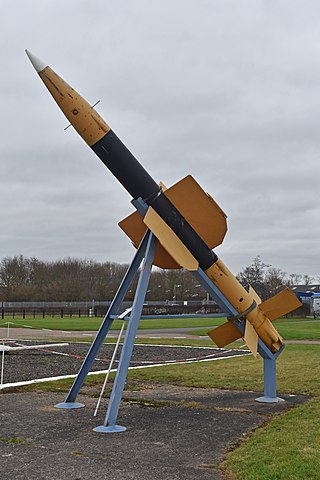History

Initial work
In the post-war era, Elliott Brothers began concentrating on automation solutions for fire control, and on 1 December 1946 they began work on what would develop into the CDS. The initial idea was to collect ASDIC data on various targets from different ships in a task group and then produce a single unified view using a new display system that overlaid symbols on a large-format plan-position indicator (PPI) radar display. [lower-alpha 1] Elliott received a patent for this "Peevish" system in 1947. [4]
Although the initial concept was to net ASDIC data, in 1947 attention turned to the aircraft plotting problem; [5] toward the end of the Second World War, Allied non-automated fighter direction experienced saturation and degraded performance when subjected to Kamikaze attacks. [6] The key development was a new effort to develop a powerful 3D radar system to replace previous designs. Eventually known as the Type 984 radar, it would so greatly increase the amount of data available that plotting it all was seen as a serious concern. [7]
The first complete system for the aircraft role was demonstrated at Elliott's Borehamwood research center in June 1950. This eventually led to a contract for two prototype versions; the original prototype was delivered as "X1" to the Admiralty Research Establishment in Witley in 1951, and a second newly built model, "X2", which was paid for by the US Navy's Bureau of Ships but officially on permanent loan to the US Naval Research Laboratory. [8] [9]
Royal Navy use
At first, there was no pressing need for the CDS, and production was not undertaken. However, the development of the Seaslug missile set off a series of events that led to the introduction of CDS some years later. [10] Seaslug required the long-range and height-finding of the Type 984 [11] but the County-class destroyers, the only ships armed with Seaslug [lower-alpha 2] , were too small to carry the large radar. [lower-alpha 3] [11]
The solution was to add a digital data link to CDS, called Digital Picture Transmission (DPT) or Link I; [14] the use of a digital link may have been inspired by DATAR's digital link. [15] The aircraft carrier transmitted radar contact data from its Type 984 over DPT to the escorting County destroyers, [14] which used the data to locate targets with their smaller radars for Seaslug. Pye Ltd. was given the production contract. [9]
The CDS/Type 984 combination entered service with HMS Victorious [16] in 1958, [10] having been fitted during the ship's extensive post-war refit. [16] On 15-20 July 1959, the ship participated in the Riptide military exercise with the United States Navy and demonstrated the effectiveness of the system; CDS provided a "decisive advantage" that allowed inferior RN fighters to "grossly outperform" USN fighters. [16] [14] The USN was unable to saturate RN fighter direction. [10]
This was followed with the CDS being fitted to the new HMS Hermes and the first batch of four of the eight County-class destroyers. [8] Unknown to the developers of the original CDS, another division within Elliott was developing a purely electronic version of the same basic concept, the Action Data Automation, and a developed version of this system would ultimately replace the original model on most RN ships. [9]
British Army and RAF
Starting in 1949, the British Army began development of a new tactical control radar that would provide early warning and putting-on information for up to sixteen dispersed batteries of anti-aircraft artillery spread over a city-wide area. This presented the same sort of problem that the Navy faced with its dispersed destroyers; the AA guns had small radars on-site, but these did not provide a long-range picture of the battle as a whole. They learned of the CDS and became interested in adapting it for the new radar. During development, in 1953 the role of air defence over the UK passed from the Army to the Royal Air Force, who took up development and renamed the radar the AMES Type 82. [17]
In this role, the renamed Data Handling System (DHS) was somewhat more complex, consisting of separate operators to handle initial detection and picking out tracks that were interesting, then handing off those tracks to detail trackers who continued fine-tracking of the targets. A third set of operators handed separate height-finding radars (if used) and the identification friend-or-foe interrogators, feeding that information into the system on a less frequent basis. Those detailed tracks could then be sent to the AA sites, where the data could automatically cue, or "lay-on", their local radars. [18]
The Type 82 was used in its intended military role for only a short period, before being passed off to mixed military/civilian air traffic control role in the midlands. In this role, the DHS proved invaluable in handling large numbers of aircraft movements. The system remained in service into the 1980s. [19]
US Navy development
The US Navy was "wowed" by the demonstration CDS when they visited Borehamwood in 1950. This led to the construction of the X2 model, which arrived at the Naval Research Center in 1952. X2 "did much to sell the concept" of the CDS, but they found many details that concerned them. [5]
Foremost was its size, which would limit it to larger ships. They were more interested in a system that could be used on a large portion of the fleet. They also found it to be sensitive to changes in temperature, lacking precision, and given its large number of moving parts, difficult to maintain. A final problem was that they desired a system capable of tracking hundreds of objects, not dozens, and adding the additional channels to the CDS would be expensive. [8]
This led to their own version, the Electronic Data System. This was very similar to the original CDS but included a number of detail changes. Happy with the results, in 1955 the Bureau of Ships sent a contract to Motorola to build 20 EDS systems. The first was installed on USS Willis A. Lee in 1956, then on the four ships of Destroyer Division 262, and as well as a selection of guided missile cruisers. During tests in 1959, the ships of 262 were able to exchange data using the SSA-21 at ranges up to 400 miles (640 km). [20]
Most of these units remained in use through the 1960s, finally being replaced in 1968 by the Navy Tactical Data System. [20]
USAF interest
The prototype CDS was also viewed by the US Air Force, who were at that time exploring their needs for air plotting. They were already involved in the project that would ultimately emerge as the all-digital SAGE system but were exploring alternatives as well. One of these was proposed by the University of Michigan's Willow Run Research Center, who suggested adding a data transmission system to CDS. [21] Ultimately the Air Force continued with the original SAGE development, whose AN/FSQ-7 computers were the largest ever built. [10]

















